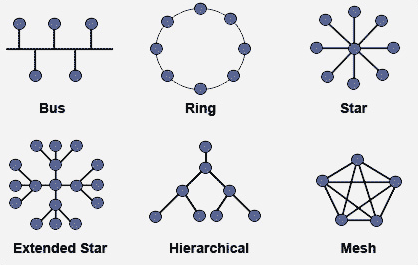Networking
What is Networking?
Computers can either be 'stand alone' or networked. Networked computers are better to use in an office building or a school, as they allow for
data to be shared between them, and for different peripheral devices to be shared.
Networks work by having client and servers. The client sends a request to the server, and the server then responds by providing the item the client had requested.
In networks the computer is referred to as the client.
However in networks today there the client can be accessing many servers at one, whilst at the same time there can be one server providing for many clients at
the same time.
There are six different network topologies that can be used to create a network. These are:
- Bus
- Ring
- Star
- Extended Star
- Hierarchical
- Mesh

Ideally when networking, you would try to implement the mesh network, as multiple connections to each client, server and peripheral on the network would
mean a lesser chance of network failure if cables became disconnected.
History of Networking
Since 1940 computer networks have rapidly developed from sending calculations between two machines, to being at the centre of modern communication methods.
Between 1940 and 1972 there were the greatest developments of network communications, with George Stibiltz initial communication of sending some mathematical
instructions in 1940, to the development of the first wide area network (WAN) in 1965.
During this time it was realised that the speed of communication could be increased between the devices, thus telephone switches were improved to become automated
in 1965, during the development of networks many Universities were the first to adopt this new communications method, leading to a large number of leading
Universities to become connected to this vast network.
The biggest breakthrough of networking was the development of the X.25, which is now used today to help expand TCP/IP networks.
Synchronous and Asynchronous communication
In general the two types of communication requires both a sender and receiver.
When communication is synchronous, it means that both the sender and receiver must be there at the same time to send and receive the information. An example of
this is using a telephone to call someone; both the sender and receiver must be present at the same time in order to communicate.
When communication is asynchronous, it means that the communication happens at different times, and that the sender and receiver do not have to be present at the
same time. An example of this is sending a email to a friend, they do not receive the email until they open their email account.
Internet as a communication
The internet uses both synchronous and asynchronous communication to allow communication between people using the internet.
The internet has features such as, instant messaging, voice calls, video calls, chat rooms and emails. You would presume that all except emails would be
synchronous communication methods, however both instant messaging and chat rooms are asynchronous, as well as emails. Instant messaging and chat rooms seem
to be synchronous, but it is the speed of today's internet that makes them seem like communications are instant.
References
- Lawrence Snyder, Fluency with information technology, third edition, Chapter 3: Making the connection, PEARSON
- The History of Networking, http://en.wikipedia.org/wiki/Computer_networking, Wikipedia, 07 Mar. 11
- Netorks Image, http://www.learn-networking.com/wp-content/oldimages/network-topology.jpg, Learn Networking, 11 Mar. 11
Copyright © SNYDER
Last Modified on
Maintained by DAN & Dale
 Ideally when networking, you would try to implement the mesh network, as multiple connections to each client, server and peripheral on the network would
mean a lesser chance of network failure if cables became disconnected.
Ideally when networking, you would try to implement the mesh network, as multiple connections to each client, server and peripheral on the network would
mean a lesser chance of network failure if cables became disconnected.